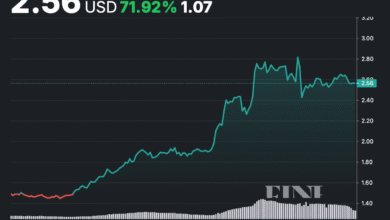Moody’s Credit Downgrade: Insights from Scott Bessent

In a striking move, Moody’s credit downgrade has sent ripples through the financial landscape, marking a pivotal moment for the U.S. economy. This recent downgrade, which lowered the nation’s credit rating from Aaa to Aa1, has been attributed by Treasury Secretary Scott Bessent to the alarming rise in government debt and interest payments, viewed as a clear reflection of the Biden administration’s spending policies. Bessent referred to Moody’s ratings as a ‘lagging indicator’, suggesting that the effects of decisions made in recent years are now becoming evident. As the administration continues to grapple with the implications of elevated tariffs and their impact on consumers, the downgrade raises pressing questions about the future of national financial stability. With an eye on the evolving economic landscape, experts and policymakers are now left to ponder what this downgrade means for American businesses and household borrowing rates moving forward.
The recent downgrade of the U.S. credit rating by Moody’s signifies a critical juncture for the nation’s fiscal reputation. Treasury Secretary Scott Bessent has labeled this significant assessment a ‘lagging indicator’, emphasizing that it reflects a long-term trend of rising government debt under the current administration. This credit appraisal aligns with discussions around the implications of federal financial management, particularly regarding Biden-era expenditures and trade policies that include tariffs. As financial analysts and market stakeholders react to this downgrade, concerns about the potential rise in interest rates for consumers and businesses are becoming increasingly pronounced. This financial reevaluation is not just a bureaucratic decision; it represents a broader warning about the country’s economic trajectory and its ramifications for everyday Americans.
Understanding Moody’s Credit Downgrade
Moody’s decision to downgrade the U.S. credit rating has sparked considerable discussion among economists and policymakers. Scott Bessent, the Treasury Secretary, referred to this downgrade as a ‘lagging indicator,’ suggesting that it reflects past economic performance rather than an accurate prediction of future trends. In his assessment, he emphasized that the rise in government debt and associated costs were not merely recent developments, but rather results of spending patterns that have evolved over several years.
The downgrade from Aaa to Aa1 by Moody’s holds significant implications, especially in terms of investor confidence and borrowing costs for the U.S. government. With increased interest payment ratios, the U.S. may face heightened scrutiny from international investors, potentially driving up interest rates for mortgages and business loans, as Sen. Chris Murphy noted. Such financial repercussions can deter investment and slow economic growth, echoing concerns about the Biden administration’s fiscal policies and their long-term sustainability.
Scott Bessent’s Critique of Credit Agencies
In his interview, Scott Bessent criticized credit rating agencies like Moody’s for their reactive nature, positing that they often reflect economic conditions after significant changes have occurred. He argued that such assessments do not capture the dynamic nature of current economic policies, particularly those implemented by the Biden administration. By labeling the downgrade as a ‘lagging indicator,’ Bessent implied that it fails to account for the positive investments being made in crucial sectors such as healthcare and climate change.
Bessent’s critique raises an essential dialogue on the role of credit agencies in the financial ecosystem. The inability of agencies to foresee the future impacts of prevailing policies might mislead investors and consumers, creating a disconnect between actual economic health and the perception dictated by rating adjustments. This commentary sheds light on the broader implications of credit ratings on economic policy-making and the challenges faced by governments aiming to stimulate economic growth amidst stringent fiscal scrutiny.
The Impact of Biden Administration Spending on Credit Ratings
Scott Bessent directly linked the Moody’s downgrade to the Biden administration’s spending strategies, suggesting that the increased government debt resulting from these policies was a key factor behind the negative credit rating. Bessent referenced investments in climate initiatives and healthcare as contributing to rising expenditure levels, framing them as essential for future growth. However, the concern remains whether these investments can be funded sustainably without compromising the country’s fiscal health.
Critics of the administration argue that unrestrained spending could lead to long-term economic instability, particularly if it is not matched by a significant increase in revenue. The potential for higher interest rates, as a consequence of a lower credit rating, might limit the administration’s ability to borrow and invest in critical areas. As Bessent pointed out, how this spending balances with the national debt will be pivotal in determining the U.S.’s economic trajectory.
Tariffs and Their Economic Implications
The discussion around tariffs further complicates the economic landscape in light of the Moody’s downgrade. Secretary Bessent highlighted communications with Walmart’s CEO regarding the company’s strategy to absorb tariff costs, reflecting a broader trend among U.S. corporations attempting to shield consumers from rising prices. This corporate maneuver carries significant implications for inflation and consumer spending, pivotal factors in the overall economic health.
Tariffs have historically been a tool for leveraging trade negotiations, but they can also initiate a chain reaction affecting the economy. As companies adjust to tariffs by increasing prices or absorbing costs, the potential consequences can result in reduced consumer purchasing power. The complex relationship between tariffs and the U.S. credit rating cannot be understated; excessive tariffs could squeeze businesses while contributing to a fiscal outlook that agencies like Moody’s might factor into their assessments.
Investor Confidence Amidst Economic Challenges
Following the downgrade by Moody’s, investor confidence is likely to face further scrutiny as stakeholders reassess their strategies. Bessent’s characterization of the downgrade as a lagging indicator could encourage some investors to view it as an opportunity rather than a caution, particularly if they believe in the long-term benefits of the Biden administration’s investments. Nevertheless, concerns about the short-term impact on interest rates persist, potentially creating hesitance among investors.
The effects of a downgraded credit rating may extend beyond immediate investment decisions; they can influence international perceptions of the U.S. economy. If global markets react negatively, it could exacerbate economic challenges by driving up borrowing costs while simultaneously dampening consumer confidence. Thus, the administration’s focus on portraying a resilient economic future in the face of criticism will be critical for restoring faith among both domestic and international investors.
The Consequence of Credit Ratings on Homeownership
In the wake of the U.S. credit downgrade, the implications for homeownership are significant, as rising interest rates can make mortgages less affordable. Scott Bessent’s comments about the ‘lagging indicator’ nature of credit ratings highlight the disconnect between current economic activities and the assessments made by rating agencies. If potential buyers perceive increased borrowing costs as a barrier, this could lead to a slowdown in the housing market, affecting everything from construction jobs to home equity.
Higher interest rates, predicted to follow the downgrade, may deter first-time homebuyers or compel existing homeowners to rethink refinancing options. Economists often view homeownership as a vital component of economic stability and growth. Thus, ongoing discussions regarding the credibility of the U.S. credit rating and associated risks become crucial, as they can shape the future landscape of real estate in America.
Responses from Political Figures on the Credit Downgrade
Political leaders have voiced varied responses to Moody’s decision to downgrade the U.S. credit rating, reflecting differing views on its implications for the economy. Notably, Senator Chris Murphy’s criticism of Bessent’s casual dismissal of the downgrade highlights concerns about its significance and potential long-term impact. Murphy articulated fears that the downgrade might signal impending recession risks, thereby warning of higher interest rates for businesses and homebuyers.
Such political discourse underlines the importance of aligning economic vision with governance strategies. As market sentiments often react to leadership perspectives, Bessent’s nonchalant reply may not resonate well with public fears about fiscal responsibility. Both parties must navigate their economic narratives carefully to reclaim public trust and sustain momentum amid competing viewpoints.
Future Trade Agreements and Economic Recovery
Bessent pointed to optimistic trade negotiations with countries like the UK and China as a means to safeguard U.S. economic interests, suggesting these agreements could mitigate tariff impacts and support economic recovery. In light of the recent credit downgrade, establishing successful trade relations becomes increasingly vital for maintaining investor confidence and stability in international markets. As the administration works to renegotiate tariffs, the successful implementation of these agreements could serve as both a buffer and an opportunity for economic growth.
Trade policy remains a crucial facet in addressing the potential ramifications of the U.S. credit rating. If the Biden administration can effectively leverage its position in negotiations, it could enhance U.S. market competitiveness and help restore investor confidence. These ventures are critical as the interaction between domestic fiscal strategies and foreign trade policies shapes the overall economic landscape post-downgrade.
The Long-Term Effects of Fiscal Policy on Credit Ratings
The debate surrounding the implications of the Biden administration’s fiscal policy on credit ratings encapsulates broader concerns about economic governance. While current spending initiatives are aimed at fostering inclusive growth, their long-term effects on national debt and credit ratings warrant careful scrutiny. The downgrade by Moody’s serves as a stark reminder of the delicate balance between stimulating growth and maintaining fiscal discipline.
Scott Bessent’s remarks echo a sentiment shared by many economists: that rigorous planning and strategic investments are essential for long-term fiscal health. Failure to guard against rising debt levels could not only pose risks to the U.S. credit rating but also create challenges in managing future economic crises. A prudent fiscal approach must remain a cornerstone of the administration’s strategy to ensure that immediate investments do not compromise long-term stability.
Consumer Perspectives on Economic Policy and Credit Ratings
Consumer sentiment plays a pivotal role in shaping the economy, and the reaction to Moody’s downgrade could impact spending behaviors significantly. Bessent’s interactions with Walmart reveal insights into how large retailers are responding to expected shifts in the market, which can, in turn, influence consumer confidence. If consumers perceive economic instability from the downgrade, they may curtail spending, exacerbating the economic slowdown.
As public discourse unfolds around the implications of federal fiscal policies, understanding consumer perspectives will be crucial. If consumers feel threatened by rising prices due to tariffs and increased costs of borrowing, the resulting hesitance could contribute to a feedback loop that further diminishes economic growth. Thus, harmonizing consumer confidence with sound economic policy represents a vital endeavor for both policymakers and businesses.
Frequently Asked Questions
What does Moody’s credit downgrade mean for the U.S. economy?
Moody’s credit downgrade signifies a reduction in the creditworthiness of the U.S., moving from Aaa to Aa1. This can lead to higher borrowing costs for the government and potentially higher interest rates for consumers and businesses, impacting economic growth.
How did Scott Bessent describe Moody’s credit downgrade?
Scott Bessent referred to Moody’s credit downgrade as a ‘lagging indicator’, suggesting that it reflects past economic conditions rather than current or future performance. He emphasized that the downgrade was influenced by the Biden administration’s spending policies.
What factors contributed to the U.S. credit downgrade by Moody’s?
Moody’s cited an increase in government debt and interest payment ratios over the past decade compared to similarly rated sovereigns as key factors in downgrading the U.S. credit rating, which has been exacerbated by the spending policies of the Biden administration.
How might tariffs impact the effects of Moody’s credit downgrade?
Tariffs can increase the cost of goods, leading to higher prices for consumers as reported by Walmart CFO. This situation compounds the effects of Moody’s credit downgrade, as increased consumer costs can slow economic growth and exacerbate financial pressures on businesses and households.
What was the response of Treasury Secretary Scott Bessent to concerns about the Moody’s downgrade?
Scott Bessent downplayed the significance of the Moody’s downgrade, stating that countries like Qatar, Saudi Arabia, and the UAE are continuing to invest in the U.S. economy, indicating their confidence despite the downgrade.
What implications does the Moody’s credit downgrade have on interest rates?
The Moody’s credit downgrade could lead to rising interest rates as lenders perceive a higher risk in U.S. government bonds, affecting loan rates for businesses and individuals looking to purchase homes or secure financing.
Did Scott Bessent indicate that the credit downgrade was immediate or long-term?
Scott Bessent implied that the credit downgrade reflects long-term trends related to federal spending and debt accumulation rather than immediate economic conditions, highlighting the cumulative nature of the situation.
How can consumers expect prices to change following the Moody’s credit downgrade and related tariffs?
Following the Moody’s credit downgrade and ongoing tariffs, consumers could see increased prices as companies like Walmart absorb some tariff costs but also pass some to consumers, potentially leading to inflationary pressures.
How does the Biden administration’s spending relate to the Moody’s credit downgrade?
The Biden administration’s spending policies, described as investments in key sectors, have been criticized by Bessent as contributing factors to the Moody’s credit downgrade, indicating concerns about future debt levels.
What was the reaction from lawmakers regarding the Moody’s credit downgrade?
Sen. Chris Murphy expressed concern that the Moody’s credit downgrade could signal a recession, suggesting it might lead to higher interest rates complicating business and housing purchases.
| Key Point | Details |
|---|---|
| Moody’s Credit Downgrade | Moody’s downgraded the U.S. credit rating from Aaa to Aa1, citing increasing government debt and interest payments. |
| Scott Bessent’s Remarks | Treasury Secretary Scott Bessent called Moody’s ratings a ‘lagging indicator’ and linked the downgrade to the Biden administration’s spending policies. |
| Impact on Economy | Sen. Chris Murphy expressed concerns that the downgrade could signal a recession and lead to higher interest rates. |
| Walmart’s Tariff Absorption | Walmart CEO Doug McMillon stated they would absorb tariffs akin to previous years, despite potential price increases for consumers. |
| Bessent’s Perspective on Downgrade | Bessent dismissed concerns about the downgrade’s relevance on international investment, arguing that it did not affect other nations. |
Summary
Moody’s credit downgrade has sparked significant discussion, particularly from Treasury Secretary Scott Bessent, who emphasized that the downgrade is a ‘lagging indicator’ in the context of ongoing economic policies. This situation not only reflects the administration’s spending activities but also raises concerns about potential impacts on interest rates and overall economic health. As discussions continue, it is vital to closely monitor how these ratings influence both domestic and international perceptions of the U.S. economy.




